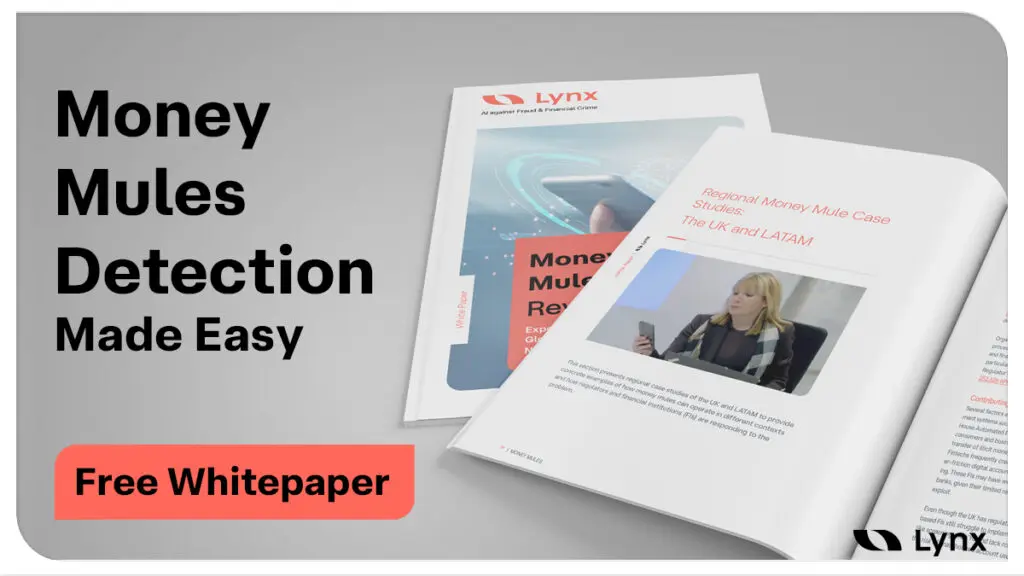Organised crime groups (OCGs) exploit vulnerabilities in financial institutions (FIs) to recruit and onboard money mules to launder billions of dollars annually. Criminals have adapted alongside changing technologies to target FIs and their customers at scale, leveraging social media platforms, crime-as-a-service (CaaS), AI-powered tools, and breached identity data to socially engineer victims, create fake identities, and bypass security measures like identity verification (IDV) and know your customer (KYC).
Money mules play an increasingly crucial role in legitimising OCG profits from digital crimes such as authorised push payment fraud (APPF), identity theft, and phishing, along with proceeds from physical crimes, including drug trafficking, smuggling, and human trafficking. Three main types of money mules—compromised, recruited, and fake mules—highlight how criminals exploit FIs and use mule accounts to launder money.
Global and regional task forces and regulatory bodies are taking steps to address the serious money mule and money laundering problem. These efforts drive changes in AML and fraud prevention practices that impact money muling.
FIs globally continue to grapple with financial losses and increased operational costs, and some FIs now face regulatory penalties as illicit funds flow through their systems and fuel more criminal activity. The dynamics of money mules are unique in each region and country. For instance, in the UK, APPF and money muling are increasingly intertwined and impactful. New regulations around APPF reimbursement are expected to drive more investment in mule detection technologies. In contrast, new digital banks, person-to-person mobile money transfers, and payment services across Latin America are increasing financial access for underbanked people and businesses but making it easier for OCGs to commit digital crimes and onboard money mules to launder illicit profits. Regulations remain inconsistent across the region.
Regardless of the region or country, FIs are facing money mule and money laundering risks due to the real-time availability of their digital products and services, but lack real-time solutions. They are unable to detect if funds customers receive are from illicit sources or identify if a customer is exhibiting malign behaviour in real-time. Traditional fraud prevention and AML methods which use unsupervised machine learning (ML) are reactive and ineffective against money mules, allowing mules to launder money unchecked and creating a vicious cycle of crime.
Money muling is a real-time problem that requires a real-time solution. FIs need to detect and stop illicit funds and mules in real time to block suspicious activity, prevent illicit funds from leaving their systems, and shut down mule accounts.
FIs must use supervised ML models that learn from labelled data and retrain daily to avoid drift and performance degradation given ever-evolving criminal tactics, customer behaviours, and emerging technologies. These models detect more money mules while blocking fewer legitimate transactions.
Lynx’s Daily Adaptive Models (DAMs) use supervised learning, retrain with the latest transaction data daily, and integrate diverse non-transaction data sources to detect more money mules. Key benefits from DAMs include real-time detection, improved accuracy, reduced operational costs and analyst fatigue, and enhanced regulatory compliance.
Lynx built one Tier 1 banking customer, a money mule DAM, which achieved a 65% account detection rate (ADR) and a 70% value detection rate (VDR) at a low rate of 10 false positives per 10,000 transactions—a significant improvement over the bank’s previous model—with a response time of less than 100ms.
Reach out to schedule a proof of concept; no PII is required. Lynx will analyse your transaction data to demonstrate how many undetected or dormant mule accounts you have and how much money you could save.

The Payments Association
St Clement’s House
27 Clements Lane
London EC4N 7AE
© Copyright 2024 The Payments Association. All Rights Reserved. The Payments Association is the trading name of Emerging Payments Ventures Limited.
Emerging Ventures Limited t/a The Payments Association; Registered in England and Wales, Company Number 06672728; VAT no. 938829859; Registered office address St. Clement’s House, 27 Clements Lane, London, England, EC4N 7AE.







Log in to access complimentary passes or discounts and access exclusive content as part of your membership. An auto-login link will be sent directly to your email.
We use an auto-login link to ensure optimum security for your members hub. Simply enter your professional work e-mail address into the input area and you’ll receive a link to directly access your account.
Instead of using passwords, we e-mail you a link to log in to the site. This allows us to automatically verify you and apply member benefits based on your e-mail domain name.
Please click the button below which relates to the issue you’re having.
Sometimes our e-mails end up in spam. Make sure to check your spam folder for e-mails from The Payments Association
Most modern e-mail clients now separate e-mails into different tabs. For example, Outlook has an “Other” tab, and Gmail has tabs for different types of e-mails, such as promotional.
For security reasons the link will expire after 60 minutes. Try submitting the login form again and wait a few seconds for the e-mail to arrive.
The link will only work one time – once it’s been clicked, the link won’t log you in again. Instead, you’ll need to go back to the login screen and generate a new link.
Make sure you’re clicking the link on the most recent e-mail that’s been sent to you. We recommend deleting the e-mail once you’ve clicked the link.
Some security systems will automatically click on links in e-mails to check for phishing, malware, viruses and other malicious threats. If these have been clicked, it won’t work when you try to click on the link.
For security reasons, e-mail address changes can only be complete by your Member Engagement Manager. Please contact the team directly for further help.